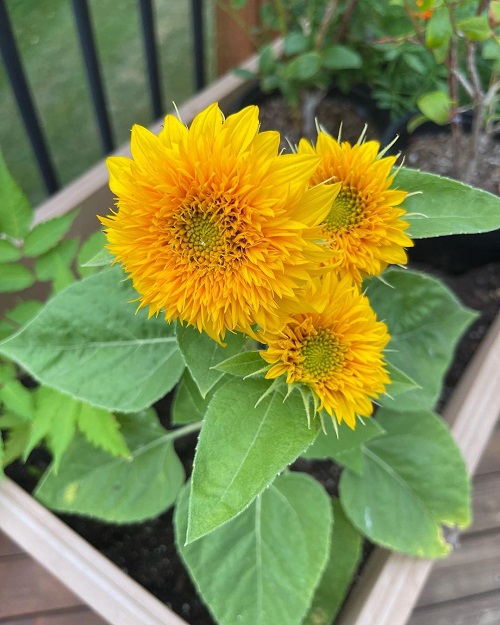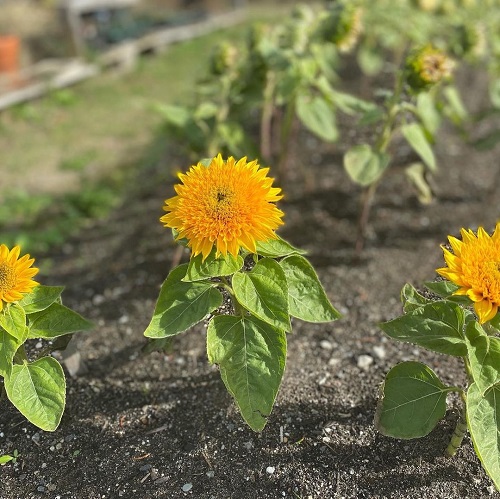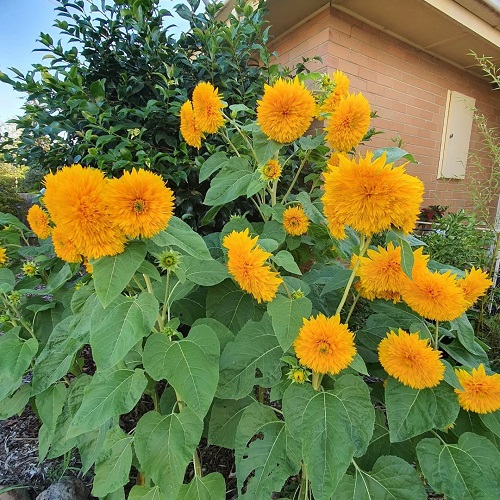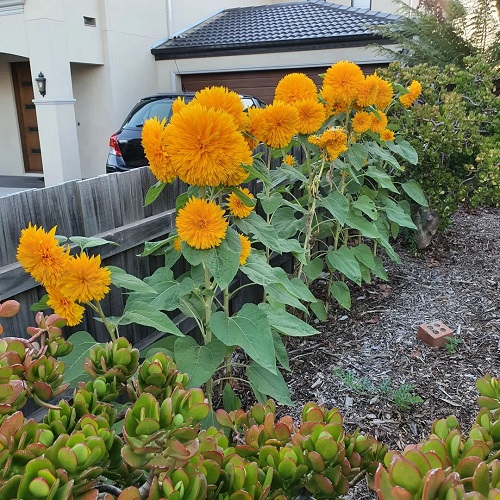Learn How to grow Teddy Bear Sunflowers in your own garden. Experience the joy of watching them bloom and bring warmth to the surroundings.

If you’re eager to plant vibrant Teddy Bear Sunflowers in your garden, this guide will assist you with easy-to-follow steps. Discover the secrets to nurturing these charming sunflowers and enjoy their cheerful presence in your outdoor space.
Check out 42 Best Sunflower Companion Plants here
Teddy Bear Sunflowers Information
Teddy Bear Sunflowers are a member of the Helianthus annuus family. They are compact plants known for its dwarf size. Unlike their towering counterparts, they reache a maximum height of 3 feet even when grown directly in the garden with ample space and nutrients.
During the blooming season, each plant produces a few charming flowers that resemble fluffy pom poms, exuding a radiant golden aura. These delightful blooms, although smaller than the giant sunflowers, has a diameter of just a few inches and do not yield an abundance of seeds like their larger counterparts.
The Teddy Bear Sunflower also possesses ornamental value through its large, heart-shaped leaves. With a smooth texture on the topside, these dark green leaves beautifully complement the golden blossoms, creating a cheerful ambiance in your garden or on your patio.
Check 5 Beautiful Black and White Sunflower Varieties here
Propagating Teddy Bear Sunflowers

For outdoor sowing of Teddy Bear Sunflowers seeds, it is recommended to wait until the soil temperature reaches a range of 65-85˚F, as this provides the optimal conditions for successful germination.
- Use a small container and fill it with soil or compost.
- Place Teddy Bear Sunflower seeds (1-3) in each pot, ensuring they are approximately half an inch deep in the soil.
- Water the pots thoroughly, making sure not to oversaturate the soil.
- Position the pots on a windowsill or any other location that receives ample sunlight.
- Teddy Bear Sunflower seeds will germinate in about 3-5 weeks.
Here are 12 Simple Seed Germination Tips To Grow Every Seed
Requirements for Growing Teddy Bear Sunflowers

Location
Teddy Bear Sunflowers require plenty of sunlight to thrive and produce their characteristic blooms. Like most sunflowers, they are sun-loving plants that require full sun to grow and develop properly.
Teddy Bear Sunflowers need at least 6 to 8 hours of direct sunlight per day. They should be planted in an area that receives abundant sunlight without significant shade or obstruction.
It is best to plant them in a south-facing location if possible. This ensures they receive the maximum amount of sunlight throughout the day.
Soil
Teddy Bear Sunflowers are resilient and adaptable. They can tolerate poor soil as long as it’s well-drained. Adding mulch and compost improves aeration and water retention and prevents pests and diseases.
Learn some Great Tips to Rejuvenate Your Old Soil here
Teddy Bear Sunflowers prefer slightly acidic to neutral soil with a pH range between 6.0 and 7.5.
Water
These plants can tolerate some dryness in the soil, and it is important to avoid overwatering, as waterlogged conditions can harm the plant.
Keep the soil moist but not overly saturated. For best growth, water Teddy Bear Sunflowers when the topsoil feels a little dry to the touch.
Here are the best ways to water plants
Teddy Bear Sunflower Care

Fertilizer
Teddy Bear Sunflowers benefit from a higher amount of nitrogen to support their vigorous growth and foliage development. A liquid ratio of 10-10-10 or 20-10-10 will be a good option.
Dilute the feed to half of its strength and use it once in 4-5 weeks. This will boost the growth and blooms of the plant.
Want to Make Organic Fertilizers from Kitchen Scraps? Click here
Deadheading
Deadheading is a beneficial practice that can help promote prolonged flowering and a neater appearance. Start deadheading once the flowers start to fade or wilt. This is typically after the flowers have fully bloomed and begun to decline.
To deadhead, locate the stem just below the faded flower head. Using your fingers or sharp pruning shears, pinch or cut the stem right above the next set of leaves or buds. This ensures that you remove the entire spent flower head without damaging the remaining plant.
Continue deadheading throughout the blooming season as new flowers fade. This practice encourages the plant to redirect its energy from seed production to produce new blooms.
Pests and Diseases
Teddy Bear Sunflowers, like other sunflower varieties, are generally resistant to many pests and diseases. However, they can still be susceptible to certain issues.
One common pest is aphid. You can try spraying the plants with a mild soapy water solution or using insecticidal sprays specifically formulated for aphid control.
Another potential pest is the sunflower moth, whose larvae feed on the seeds of the sunflower heads. Regular inspection of the flowers and prompt removal of any infested heads can help prevent the spread of this pest.
Additionally, covering the developing flower heads with fine mesh or nylon stockings can provide a physical barrier against the moths.
Click here to learn the Amazing Natural Pesticide Recipe that can Kill any Pest
As for diseases, Teddy Bear Sunflowers can be susceptible to fungal infections such as powdery mildew and downy mildew. Powdery mildew appears as a white, powdery coating on the leaves, while downy mildew presents as yellow patches with a fuzzy, grayish growth on the undersides of leaves.
To prevent these diseases, provide adequate spacing between plants to promote air circulation and avoid overhead watering. If necessary, apply fungicides labeled for mildew control, following the instructions on the product.


